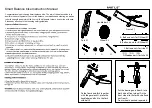
18
19
PART I
(continued from previous page...)
If, in spite of carefully adjusting the saddle height,
tilt and fore-and-aft position, your saddle is still
uncomfortable, you may need a different saddle
design. Saddles, like people, come in many different
shapes, sizes and resilience. Your dealer can help you
select a saddle which, when correctly adjusted for
your body and riding style, will be comfortable.
WARNING
some people have claimed that extended riding
with a saddle which is incorrectly adjusted
or which does not support your pelvic area
correctly can cause short-term or long-term
injury to nerves and blood vessels, or even
impotence.
If your saddle causes you pain, numbness or
other discomfort, listen to your body and stop
riding until you see your dealer about saddle
adjustment or a different saddle.
3.C - handlebar height And Angle
Your bike is equipped either with a “threadless”
stem, which clamps on to the outside of the steerer
tube, or with a “quill” stem, which clamps inside the
steerer tube by way of an expanding binder bolt. If
you aren’t absolutely sure which type of stem your
bike has, ask your dealer.
If your bike has a “threadless” stem (fig 6), your
dealer may be able to change handlebar height by
moving height adjustment spacers from below the
stem to above the stem, or vice versa. Otherwise,
you’ll have to get a stem of different length or rise.
Consult your dealer. Do not attempt to do this
yourself, as it requires special knowledge.
If your bike has a “quill” stem (fig 7), you can ask
your dealer to adjust the handlebar height a bit by
adjusting stem height.
A quill stem has an etched or stamped mark on
its shaft which designates the stem’s “Minimum
Insertion” or “Maximum Extension”. This mark must
not be visible above the headset.
WARNING
A QUIll sTem’s “mInImUm InseRTIon mARk”
mUsT noT Be vIsIBle ABove The ToP of The
heAdseT.
If the stem is extended beyond the minimum
insertion mark the stem may break or damage
the fork’s steerer tube, which could cause you to
lose control and fall.
















































